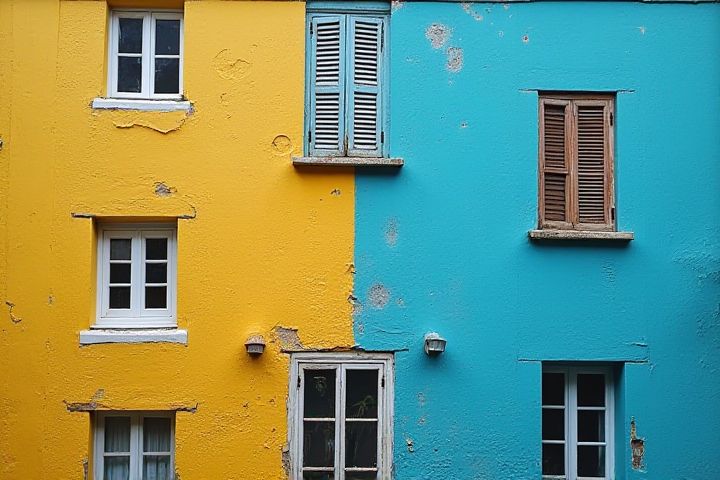
Repainting your house is essential for maintaining its aesthetic appeal and structural integrity. Generally, the exterior paint should be refreshed every 5 to 10 years, depending on factors like climate, sun exposure, and the type of paint used. Signs that indicate your house needs repainting include peeling, cracking, or fading paint, as well as moisture damage or mold growth. For interiors, consider repainting every 3 to 7 years, particularly in high-traffic areas or spaces where the color is likely to change due to wear and tear. Regularly inspecting your home's paint condition can extend its lifespan and enhance your property's value.
When Should A House Be Repainted
Fading color indicates paint wear.
Fading color is a primary indicator that your house's exterior paint is wearing out and may need to be refreshed. Generally, if you notice that the original hue has noticeably dulled or lost vibrancy, it's time to consider repainting, which typically occurs every 5 to 10 years, depending on the paint quality and climate conditions. The presence of fading also suggests reduced protection against elements, increasing vulnerability to moisture and sun damage. Checking for these signs regularly can help maintain your home's aesthetic appeal and longevity.
Visible chipping or peeling.
Visible chipping or peeling of paint indicates that your home's exterior is losing its protective barrier against environmental elements. You should consider repainting as soon as you notice these signs, as they can expose the underlying material to moisture, leading to potential damage like rot or mold. Regular inspections every few years can help you catch these issues early. Maintaining a fresh coat not only enhances your home's curb appeal but also extends the life of its surfaces.
Caulking shows cracks.
If you notice caulking that shows cracks, it is time to consider repainting your house, as this can indicate deterioration in your home's exterior protection. Typically, repainting is recommended every 5 to 10 years, depending on your local climate and the materials used. Cracks in caulking can allow moisture to seep in, leading to potential damage and higher repair costs down the line. Regular inspections of your home's exterior can help you maintain its appearance and structural integrity.
Mold or mildew presence.
Repainting your house becomes crucial when you notice mold or mildew growth, as these fungi can not only damage paint but also pose health risks. Inspect areas with high humidity, such as bathrooms and basements, for signs of discoloration or a musty odor, indicating moisture issues that promote mold. When these issues are detected, it's essential to address the underlying moisture problem before repainting, ensuring a long-lasting and healthy environment. Choosing a high-quality, mold-resistant paint for your home can help prevent future infestations while enhancing the overall appearance of your space.
Exposure to harsh weather.
A house exposed to harsh weather conditions, such as extreme sunlight, heavy rain, or strong winds, typically requires repainting every 3 to 5 years. Sunlight can cause paint to fade and crack, while moisture can lead to peeling and mold growth. You should regularly inspect your exterior surfaces for signs of wear; areas with flaking or discoloration indicate that it's time for a refresh. Keeping your house well-painted not only enhances its aesthetic appeal but also protects wood and siding from damage, preserving your investment.
Significant surface staining.
Significant surface staining on your home's exterior often indicates it's time for a repaint, particularly if the stains are noticeable from a distance or affect the overall appearance. Homeowners should consider repainting when stains accumulate to about 20% of the surface area, as this can compromise not only aesthetics but also protective coatings. If you observe mold, mildew, or fading paint after approximately 5 to 10 years, those are strong indicators for a repaint. Regular inspections and timely maintenance can prevent further damage, ensuring your home retains its value and curb appeal.
Noticeable chalkiness.
Noticeable chalkiness on exterior paint indicates that the protective film is degrading due to weather exposure, UV rays, or moisture. When you observe this chalky residue, it's a clear signal that your house needs repainting to maintain its aesthetic appeal and protect the underlying surface. Repainting promptly prevents further damage, such as wood rot or mold growth, which can arise from prolonged exposure. To keep your home looking fresh and safeguarded, schedule a repainting session when you detect this chalkiness, ideally every five to seven years, depending on your climate.
Increased energy bills.
If you notice a significant rise in your energy bills, this could be a strong indicator that your house needs repainting. A faded or peeling exterior paint can reduce the insulation properties of your home, allowing heat to escape during winter and making air conditioning less effective in the summer. Regular maintenance, typically every 5 to 7 years, ensures your home remains energy-efficient. By prioritizing repainting when needed, you could reduce energy consumption by up to 15%, translating into substantial savings over time.
Planned home sale.
Repainting your house before a planned home sale can significantly enhance its market appeal and potentially increase its value. Aim to repaint during spring or fall, as these seasons typically offer optimal weather conditions and can lead to quicker drying and better finishes. Focus on neutral colors, which are more attractive to prospective buyers and create a versatile backdrop for their furnishings. A fresh coat of paint not only updates the aesthetics of your home but also signals to buyers that the property has been well-maintained.
Remodeling or updates.
A house should be repainted every 5 to 10 years, depending on factors like weather exposure and paint quality. Signs that it's time for a fresh coat include fading, peeling, or chipping paint, particularly on exterior surfaces. For interior spaces, consider repainting if you notice persistent stains or if your style preferences change. Regular updates can enhance your home's curb appeal and increase its market value, making timely repainting a worthwhile investment.
